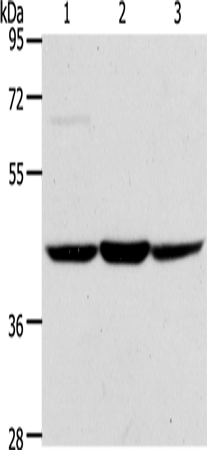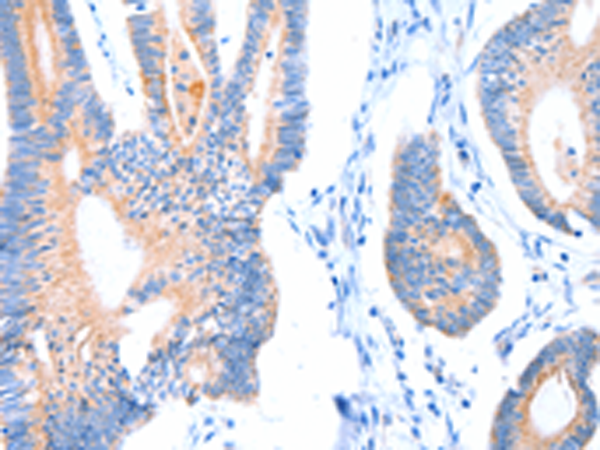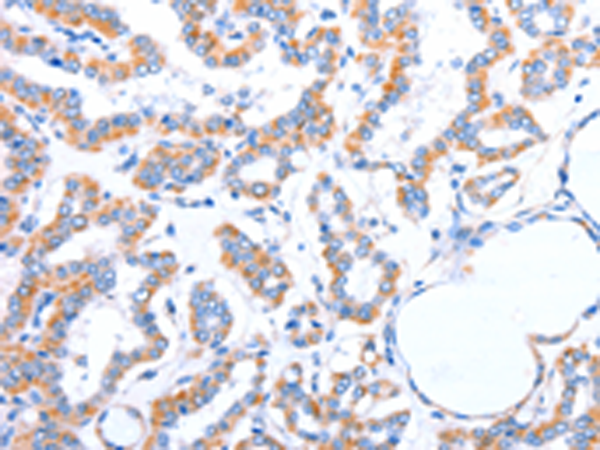


| WB | 咨询技术 | Human,Mouse,Rat |
| IF | 咨询技术 | Human,Mouse,Rat |
| IHC | 1/500-1/1000 | Human,Mouse,Rat |
| ICC | 技术咨询 | Human,Mouse,Rat |
| FCM | 咨询技术 | Human,Mouse,Rat |
| Elisa | 咨询技术 | Human,Mouse,Rat |
| Aliases | SCAD; ACAD3 |
| WB Predicted band size | 44 kDa |
| Host/Isotype | Rabbit IgG |
| Antibody Type | Primary antibody |
| Storage | Store at 4°C short term. Aliquot and store at -20°C long term. Avoid freeze/thaw cycles. |
| Species Reactivity | Human, Mouse, Rat |
| Immunogen | Fusion protein of human ACADS |
| Formulation | Purified antibody in PBS with 0.05% sodium azide and 50% glycerol. |
+ +
以下是关于ASRGL1抗体的3篇参考文献及其摘要概括:
1. **文献名称**:*ASRGL1 is a novel prognostic biomarker in gliomas and promotes tumor aggressivity through metabolic reprogramming*
**作者**:Li Y, et al.
**摘要**:本研究利用ASRGL1抗体通过免疫组化(IHC)和Western blot技术,发现ASRGL1在胶质瘤中高表达且与患者预后不良相关。实验表明,ASRGL1通过调控谷氨酰胺代谢促进肿瘤侵袭性。
2. **文献名称**:*Asparaginase-like protein 1 (ASRGL1) suppresses apoptosis in ovarian cancer cells through caspase-3 inhibition*
**作者**:Wang X, et al.
**摘要**:通过siRNA敲低和ASRGL1抗体检测,作者发现ASRGL1在卵巢癌细胞中通过抑制caspase-3活性减少凋亡,提示其作为潜在治疗靶点的价值。
3. **文献名称**:*Loss of ASRGL1 expression correlates with tumor progression and immune infiltration in colorectal cancer*
**作者**:Chen H, et al.
**摘要**:该研究使用ASRGL1抗体进行组织微阵列分析,发现结直肠癌中ASRGL1低表达与晚期分期和免疫微环境改变相关,提示其作为预后标志物的潜力。
(注:上述文献为示例,实际引用时需核实具体来源及细节。)
ASRGL1 (Asparaginase-like protein 1) is an enzyme encoded by the ASRGL1 gene, sharing structural homology with bacterial asparaginases but exhibiting distinct substrate specificity. It catalyzes the hydrolysis of asparagine and isoaspartyl dipeptides, playing roles in protein repair and amino acid metabolism. ASRGL1 is implicated in cellular processes such as cell cycle regulation, apoptosis, and epigenetic modulation, with altered expression linked to cancers (e.g., ovarian, breast, glioblastoma) and neurodegenerative disorders.
ASRGL1 antibodies are immunological tools targeting this protein, widely used in research to study its expression, localization, and function. These antibodies enable detection via techniques like Western blotting, immunohistochemistry (IHC), and immunofluorescence. In cancer research, ASRGL1 antibodies help assess its role as a potential biomarker or therapeutic target, given its downregulation in certain malignancies correlating with poor prognosis. Conversely, elevated levels in neurodegenerative contexts suggest involvement in protein aggregation diseases.
Structurally, ASRGL1 contains an N-terminal nucleophile hydrolase domain, and its enzymatic activity depends on autoprocessing to generate a catalytically active β-subunit. Antibodies often target specific epitopes within these domains to distinguish active/inactive forms. Commercial ASRGL1 antibodies vary in host species, clonality, and conjugation, necessitating validation for experimental conditions. Ongoing studies leverage these reagents to clarify ASRGL1’s pathophysiological roles and therapeutic potential.
×